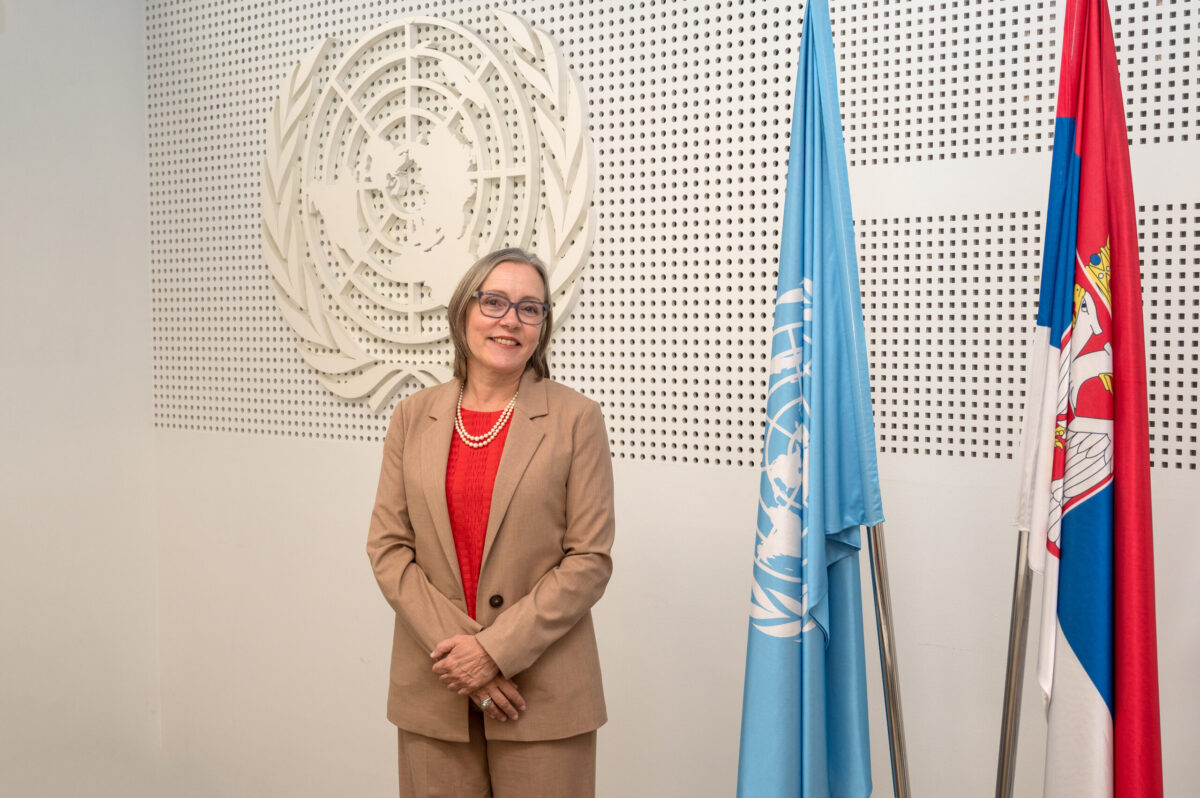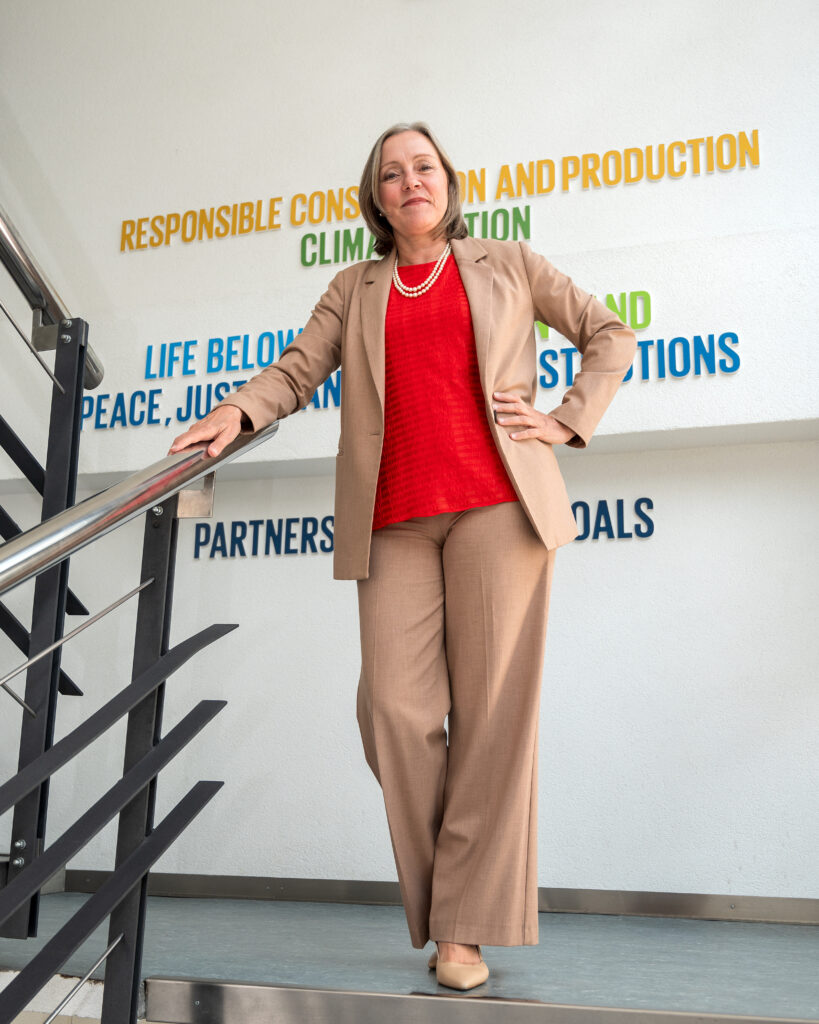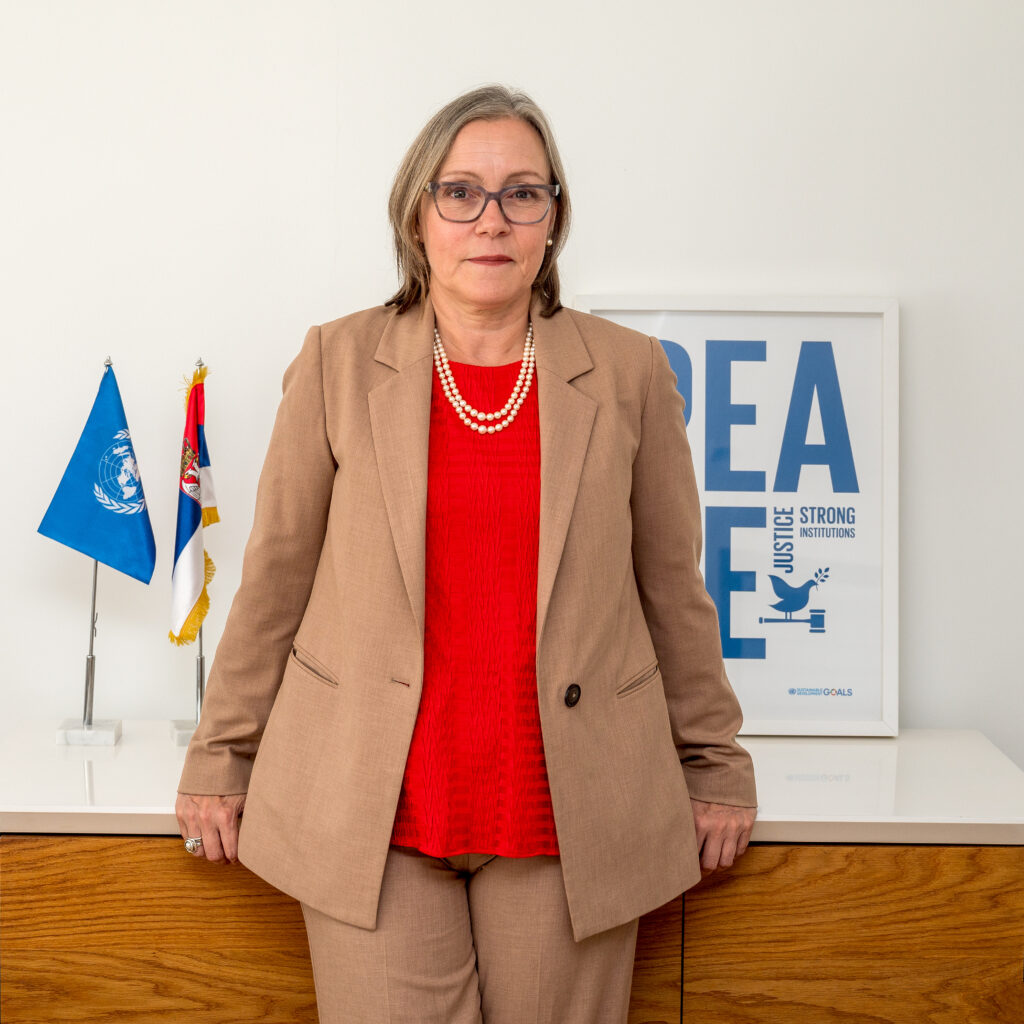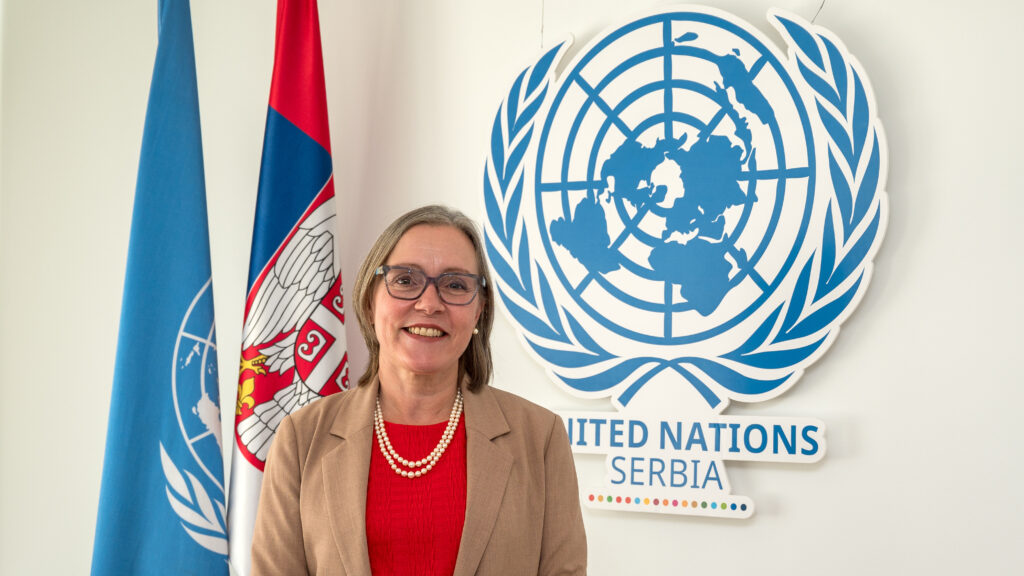In today’s troubled world, the 2030 Agenda is a blueprint for survival more than ever
 In an exclusive first interview with Serbian media, we are honoured to welcome Matilde Mordt, the newly appointed UN Resident Coordinator in Serbia. With a distinguished career in international development and human rights, Ms Mordt steps into what are the biggest development challenges that humanity is facing a time of significant global and regional challenges. Today, she shares her vision for strengthening the partnership between the United Nations and Serbia, highlighting key priorities and the path forward in addressing shared goals.
In an exclusive first interview with Serbian media, we are honoured to welcome Matilde Mordt, the newly appointed UN Resident Coordinator in Serbia. With a distinguished career in international development and human rights, Ms Mordt steps into what are the biggest development challenges that humanity is facing a time of significant global and regional challenges. Today, she shares her vision for strengthening the partnership between the United Nations and Serbia, highlighting key priorities and the path forward in addressing shared goals.
A recent UN report has highlighted significant setbacks in achieving the Sustainable Development Goals globally. What are the most critical factors hindering progress, and what immediate actions should the international community prioritize to accelerate the achievement of these goals?
Let me start by emphasizing the importance of the 2030 Agenda. It took the international community years to negotiate this global framework for sustainable development, involving not only governments but also the private sector, civil society and different stakeholders around the world. The guiding question was: what are the biggest development challenges that humanity is facing, and what are the common goals that we can establish to overcome these? There was a need to address complex problems with an interdisciplinary approach, bringing together social, economic and environmental perspectives in an integrated way. The principle of “Leaving no one behind” put the focus on those most vulnerable. And the principle of universality acknowledged that the Agenda was for all countries, developed and developing alike. And so, the 17 Sustainable Development Goals (SDGs) were approved by 193 member states in September 2015. In today’s troubled world, it is a blueprint for survival more than ever.
The path to achieving the SDGs has been anything but smooth, with substantial challenges still ahead. We still feel the aftershocks of the COVID-19 pandemic, which disrupted economies, health systems, and education. Add to that the current escalation of conflicts and geopolitical tensions that are destabilizing economies and lives worldwide. Globally, over 120 million people are forcibly displaced today, a tragic record high. And let’s not forget the ever-looming threat of climate chaos; the last year has been the hottest on record, pushing us dangerously close to the 1.5°C global temperature threshold.
So, where do we go from here? First, we need to up our game in international cooperation. Massive investments are crucial, and we need a reformed global financial system to unlock the required funds. Addressing the debt crisis that haunts many developing nations is paramount. Building robust partnerships is another key — think innovative collaborations in sectors like food, energy, social protection, and digital connectivity. Transitions in these key sectors are accelerators of sustainable development.
This is not about making lofty promises; it’s about turning commitments into real, tangible actions. Monitoring systems must measure progress, identify areas needing further effort, and ensure information is transparent and available to the public.
The principle of ‘Leaving no one behind’ puts the focus on those most vulnerable
 With the upcoming Summit of the Future designed to address the increasingly interconnected challenges we face globally, what are the primary objectives of this summit, and how do you envision it reshaping international cooperation to meet both current and future threats and opportunities?
With the upcoming Summit of the Future designed to address the increasingly interconnected challenges we face globally, what are the primary objectives of this summit, and how do you envision it reshaping international cooperation to meet both current and future threats and opportunities?
The Summit of the Future is focused on revitalizing international cooperation to allow us to tackle global challenges. The goal is to agree on a forward-thinking ‘Pact for the Future’, with two annexes: a Global Digital Compact and a Declaration on Future Generations.
It builds on the momentum from the 2023 SDG Summit. By leveraging what we’ve already learned and the commitments we’ve made, the Summit of the Future tackles pressing issues related to international peace, security and development. It’s about pooling our resources and ideas to strengthen progress towards the 2030 Agenda.
And it’s not just government representatives at the table. We’re talking about a broad spectrum of voices, with diverse input, from youth activists to private sector leaders, that will make the outcomes actionable and grounded in reality. Hopefully, we will see a reinvigorated spirit of global cooperation that works for us all.
 One of the key aspects of the upcoming Summit of the Future is to include the voices of youth in shaping global policies. What role do you see for young people in this summit, and can you elaborate on how youth in Serbia are being involved to ensure their voices are heard in these critical discussions
One of the key aspects of the upcoming Summit of the Future is to include the voices of youth in shaping global policies. What role do you see for young people in this summit, and can you elaborate on how youth in Serbia are being involved to ensure their voices are heard in these critical discussions
The upcoming Summit of the Future is actively including the voices of youth in shaping global policies. Young people are no longer just future leaders; they are essential stakeholders who will live through the long-term effects of today’s decisions. The summit aims to ensure that young people have their rightful seat at the table, bringing their energy, vision, and innovative thinking to the forefront of global discussions.
In Serbia, we’ve launched an initiative to ensure that local youth are actively engaged, and their perspectives are integrated into the preparatory process of the Summit. This initiative carried out in coordination between the Ministry of Human and Minority Rights and Social Dialogue, UNDP, and the UN Resident Coordinator’s Office, is committed to ensuring that youth involvement is both authentic and effective. We’ve held youth focus group consultations in Pančevo, Šabac, Pirot and Belgrade between July and September, providing a platform for young people to voice their opinions, priorities and recommendations for the future. In addition, an online survey is being circulated to capture the views of a broader cohort of young people across Serbia. The collective insights from these activities will be compiled into a comprehensive report to support the Government’s contributions to the Summit of the Future process and discussions.
 Focusing on Serbia’s standing with the 2030 Agenda, how would you assess the country’s progress in achieving the SDGs compared to global parameters? Could you highlight some specific results and challenges Serbia faces and the strategies being implemented to address them?
Focusing on Serbia’s standing with the 2030 Agenda, how would you assess the country’s progress in achieving the SDGs compared to global parameters? Could you highlight some specific results and challenges Serbia faces and the strategies being implemented to address them?
At the halfway mark of the 2030 Agenda, Serbia stands out with some commendable achievements. The country is on track on approximately 25% of the targets of the SDGs, surpassing the global average of 18%. This is no small feat: Serbia has fully met eight targets in six key areas, such as maternal and child health, drinking water supply, census completion, and birth registration.
One area where Serbia has made notable progress over the past decades is in reducing poverty. However, after a sharp decline, we’ve reached a plateau, where it is more difficult to get the figures down. This brings us to the essential principle of leaving no one behind. The challenge now is to ensure we reach the most vulnerable populations, such as the Roma, or the elderly, especially elderly women, who often find themselves below the poverty line. Tailored policies targeting these groups are crucial.
Education is another success story. Recent revisions in preschool education policies and curricula, backed by the World Bank and UNICEF, have set a global example. Moreover, Serbia’s scientific community is thriving, with a significant number of women earning PhDs and leading various academic and research sectors. This progress in education, science, and technology sets a positive trajectory for the future.
On the other hand, Serbia still faces challenges. A key area is the transition to clean energy. However, the country is making progress and has recently adopted a new Energy and Climate Plan, which includes a target of over 45% of renewables in the country’s electricity generation mix by 2030. Such efforts will contribute to fulfilling Serbia’s commitments under the Paris Agreement. Investments are already ongoing, and other important projects, such as the desulphurization of existing thermal plants are reducing emissions and pollutants, bringing substantial benefits for the environment and public health.
Serbia’s progress so far is encouraging, but the road ahead requires sustained effort. Continued focus on inclusive policies, education, and energy transition, as well as institutional strengthening, will be key to ensuring that Serbia meets its SDG targets by 2030. It’s a collective journey, and collaboration with stakeholders across society, such as the private sector, local governments and civil society, is fundamental.
This is not about making lofty promises; it’s about turning commitments into real tangible actions
You have been in Belgrade since June. What is your first impression of Serbia?
One thing that stands out immediately when arriving is how friendly Serbs are. People are cordial and attentive and even if you don’t speak the language, you feel very welcome. There is always a helping hand, a pleasant smile, and a useful recommendation ready to guide you. I will feel at home here.
There are so many other aspects that catch your attention as a newcomer: the good food, the excellent wines, the contrasts between old and new in architecture, the historical complexities, and so on. One detail that I find marvellous is the number of bookstores there are – it is a very good sign of a society that reads a lot!
My first impressions are centred on Belgrade, as I have not had the opportunity to visit other parts of the country, except for one beautiful trip to the Gradac Gorge, and a 45 km bike ride along the Danube, leading to the marvelous Golubac Fortress. I am a nature lover and hope to be able to see many more parts of the country and enjoy beautiful sceneries, the local food and its inhabitants. I look forward!
 António Guterres, Secretary-General of the UN was present at the Opening ceremony of the Olympics. In Paris, we saw our World united and also – divided. In your opinion, how our generation can make our World a better place in four years for the LA Olympics in 2028 and Brisbane in 2032?
António Guterres, Secretary-General of the UN was present at the Opening ceremony of the Olympics. In Paris, we saw our World united and also – divided. In your opinion, how our generation can make our World a better place in four years for the LA Olympics in 2028 and Brisbane in 2032?
Looking ahead, we can channel the Olympic spirit to promote peace and dialogue. Just as the Olympic Truce calls for ceasing conflict during the Games, we should strive for ongoing dialogues and peace-building initiatives.
Another perspective at the Paris Olympics was its commitment to carbon neutrality. We can take a cue from this and champion sustainability in our daily lives – the collective actions of millions can lead to significant environmental impact.
Full gender parity was achieved for the first time at these Games, showing us that equality is a reality we can strive for. We must continue to advocate for gender equality across all spheres—be it in the workplace, education, or governance. By creating environments where everyone has an equal chance to succeed, we build a stronger and more inclusive world.
Serbia’s progress so far is encouraging, but the road ahead requires sustained effort
Moreover, the inclusion of a refugee team was a powerful statement about not leaving anyone behind. We should continue such efforts by empowering marginalized communities through inclusive policies. This extends to supporting refugees, individuals with disabilities, and other vulnerable groups by ensuring they have equal access to opportunities and resources. The Paralympics are another expression of this spirit of inclusion!
Ultimately, the Olympic Games remind us of what is possible when we unite in respect. By the time we gather for the LA and Brisbane Olympics, this spirit should guide us to celebrate not just athletic achievements, but also a world advancing towards peace, sustainability, and equality.